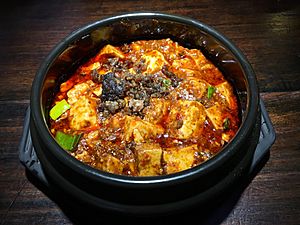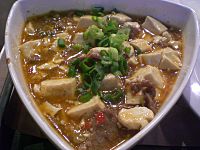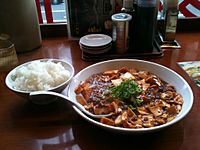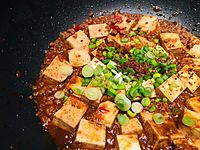Mapo tofu facts for kids

A bowl of mapo tofu
|
|
| Place of origin | China |
|---|---|
| Region or state | Sichuan |
| Main ingredients | Tofu, douban (fermented broadbean and chili paste), and douchi (fermented black beans), along with minced meat |
| Mapo tofu | |||||||||||||||||||||||||||||||
|---|---|---|---|---|---|---|---|---|---|---|---|---|---|---|---|---|---|---|---|---|---|---|---|---|---|---|---|---|---|---|---|

"Mapo tofu" in Chinese characters
|
|||||||||||||||||||||||||||||||
| Chinese | 麻婆豆腐 | ||||||||||||||||||||||||||||||
| Hanyu Pinyin | mápó dòufu | ||||||||||||||||||||||||||||||
| Literal meaning | "pockmarked old woman beancurd" | ||||||||||||||||||||||||||||||
|
|||||||||||||||||||||||||||||||
Mapo tofu (Chinese: 麻婆豆腐; pinyin: mápó dòufu) is a super popular Chinese dish from the Sichuan province. It's made with soft tofu cubes in a spicy, oily, and bright red sauce.
The sauce gets its amazing flavor from special ingredients. These include fermented broad bean and chili paste and fermented black beans. It also usually has minced meat, often beef. Sometimes, you might find it with other things like water chestnuts, onions, or wood ear fungus. People believe this dish has been around since at least 1254 in Chengdu, the capital city of Sichuan.
Contents
What's in the Name? Mapo Tofu's Story
The name "Mapo tofu" has a cool story! "Ma" comes from mázi, which means "pockmarks" or small scars on the skin. "Po" is the first part of pópo, meaning "old woman" or "grandma". So, mápó means an old woman with pockmarks on her face. This is why the dish is sometimes called "pockmarked grandma's beancurd".
A librarian named Eugene W. Wu grew up in Chengdu. He shared a story about eating this dish as a schoolboy. He said he ate it at a restaurant run by the original "Pock-Marked Ma" herself. You would order by weight, telling her how many grams of tofu and meat you wanted. She would then cook it right in front of you. It would arrive at the table fresh, smelling great, and so spicy it would make you sweat!
Mapo tofu became popular in Japan thanks to a Chinese-Japanese chef named Chen Kenmin. His son, Chen Kenichi, made it even more famous. It was one of his special dishes on the TV show Iron Chef.
What Makes Mapo Tofu Special?
Real mapo tofu is very spicy. It has two kinds of spiciness:
- Conventional "heat" spiciness: This is the burning feeling you get from chilies.
- Málà (numbing spiciness): This is a unique tingly, numbing feeling from Sichuan peppercorns. It's a key part of Sichuan food.
Chefs often describe the feeling of eating this dish using seven special Chinese words:
- má 麻 (numbing)
- là 辣 (spicy hot)
- tàng 烫 (hot temperature)
- xiān 鲜 (fresh)
- nèn 嫩 (tender and soft)
- xiāng 香 (aromatic, meaning it smells wonderful)
- sū 酥 (flaky, referring to the texture of some ingredients)
It's easier to find authentic mapo tofu outside China now. But usually, you'll find it in special Sichuanese restaurants. These places don't change the recipe to make it less spicy for people who aren't used to Sichuan flavors.
The most important ingredients for its special taste are:
- Chili broad bean paste from Sichuan's Pixian county
- Fermented black beans
- Chili oil
- Chili flakes from heaven-facing peppers
- Sichuan peppercorns
- Garlic
- Ginger
- Green onions
- Rice wine
Sometimes, cooks add water or stock, a little sugar (depending on how salty the bean paste is), and starch. Starch helps to thicken the sauce.
Different Ways to Make Mapo Tofu
You can find mapo tofu in restaurants in other Chinese provinces. It's also popular in Japan and Korea. In these places, the flavor is often changed a bit to fit local tastes.
In Western countries, the dish is often made much less spicy. This is done to make it appealing to more people. This happens a lot in Chinese restaurants that don't specialize in Sichuan cuisine.
In American Chinese cuisine, sometimes the dish is made without meat. This is for vegetarians. Instead of meat, they might use shiitake mushrooms, other edible mushrooms, or plant-based meat substitutes.
Gallery
-
Mapo tofu at a restaurant in Kobe, Japan
See also
 In Spanish: Mapo doufu para niños
In Spanish: Mapo doufu para niños




